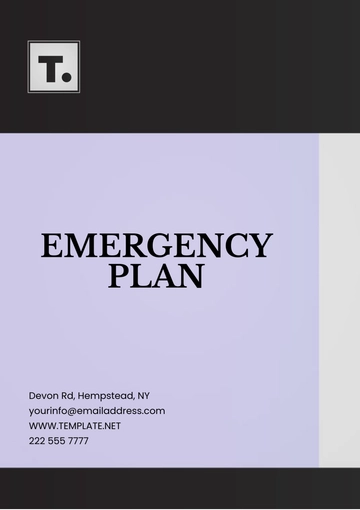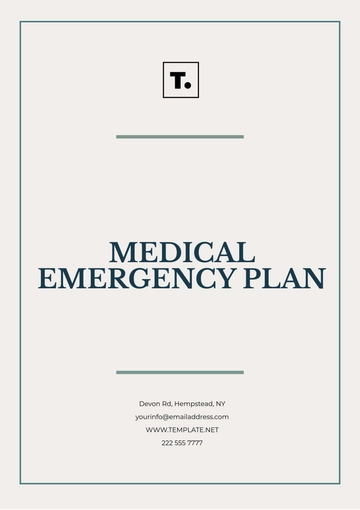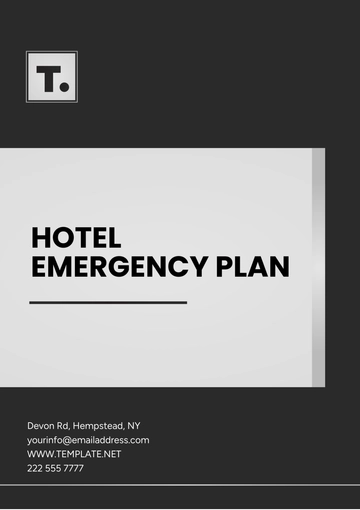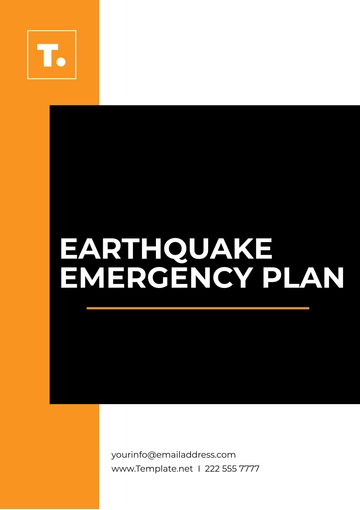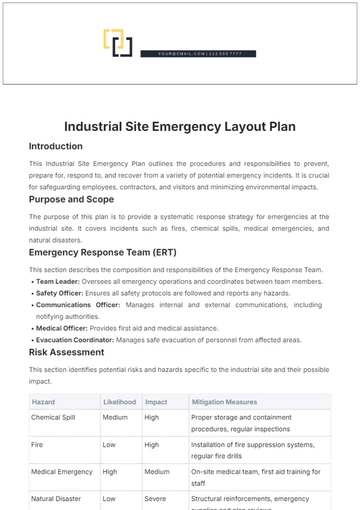Free Emergency Safety Outline Plan

1. Introduction
An emergency safety outline plan is crucial for ensuring the safety and well-being of all individuals in a facility during unexpected situations. This document provides a detailed framework to manage emergencies efficiently and effectively.
2. Objectives
The primary objectives of this plan are:
To ensure prompt and orderly response to emergencies.
To minimize injury and property damage.
To provide clear communication and instructions.
To designate roles and responsibilities.
3. Emergency Types and Responses
Various emergencies may occur. Below is a table outlining types of emergencies and initial response actions:
Emergency Type | Initial Response |
|---|---|
Fire | Activate fire alarm, evacuate the building, and call fire department. |
Medical Emergency | Call emergency medical services, provide first aid if trained. |
Severe Weather | Move to designated safe areas, monitor weather updates. |
Earthquake | Drop, cover, and hold on until shaking stops, then evacuate if necessary. |
4. Roles and Responsibilities
It is essential to define roles to ensure a coordinated response:
Emergency Coordinator: Oversee the implementation and management of emergency operations.
Floor Wardens: Assist with the evacuation of personnel and provide information to emergency services.
First Aid Team: Provide medical assistance until professional services arrive.
Communication Officer: Ensure consistent communication with emergency services and stakeholders.
5. Communication Plan
Effective communication is vital during an emergency. The communication strategy includes:
Utilize PA systems and emergency alarms for immediate alerts.
Maintain updated contact lists for all emergency personnel.
Regularly test communication equipment for reliability.
Provide clear instructions to staff and occupants during emergencies.
6. Evacuation Procedures
In the event of an emergency, an orderly evacuation procedure should be followed:
Alert all individuals in the facility via alarms and announcements.
Guide occupants to the nearest emergency exits.
Evacuate occupants to pre-designated assembly areas.
Account for all individuals and report any missing persons to emergency services.
7. Training and Drills
Regular training and drills are essential for preparedness:
Conduct annual training sessions for all employees.
Perform bi-annual emergency drills including fire, earthquake, and medical emergencies.
Review and update emergency procedures annually based on drill feedback.
Ensure all staff are familiar with emergency procedures and their specific roles.
8. Review and Update of Plan
The emergency safety outline plan should be reviewed and updated regularly to ensure effectiveness:
Conduct bi-annual reviews of the emergency plan.
Incorporate feedback from drills and actual incidents into the plan revisions.
Update contact lists and other vital information as changes occur.
Consult with local emergency services for the latest practices and procedures.
9. Conclusion
An effective emergency safety outline plan requires organization, preparation, and continued commitment to safety and education. By following this plan, we can ensure a safer environment for all individuals during emergency situations.
- 100% Customizable, free editor
- Access 1 Million+ Templates, photo’s & graphics
- Download or share as a template
- Click and replace photos, graphics, text, backgrounds
- Resize, crop, AI write & more
- Access advanced editor
The Emergency Safety Outline Plan template is designed to ensure your organization is prepared for any crisis. This customizable and downloadable template allows you to create a comprehensive safety plan tailored to your specific needs. Easily modify the content in our AI Editor Tool for maximum efficiency. It’s also printable for quick reference during emergencies.
You may also like
- Finance Plan
- Construction Plan
- Sales Plan
- Development Plan
- Career Plan
- Budget Plan
- HR Plan
- Education Plan
- Transition Plan
- Work Plan
- Training Plan
- Communication Plan
- Operation Plan
- Health And Safety Plan
- Strategy Plan
- Professional Development Plan
- Advertising Plan
- Risk Management Plan
- Restaurant Plan
- School Plan
- Nursing Home Patient Care Plan
- Nursing Care Plan
- Plan Event
- Startup Plan
- Social Media Plan
- Staffing Plan
- Annual Plan
- Content Plan
- Payment Plan
- Implementation Plan
- Hotel Plan
- Workout Plan
- Accounting Plan
- Campaign Plan
- Essay Plan
- 30 60 90 Day Plan
- Research Plan
- Recruitment Plan
- 90 Day Plan
- Quarterly Plan
- Emergency Plan
- 5 Year Plan
- Gym Plan
- Personal Plan
- IT and Software Plan
- Treatment Plan
- Real Estate Plan
- Law Firm Plan
- Healthcare Plan
- Improvement Plan
- Media Plan
- 5 Year Business Plan
- Learning Plan
- Marketing Campaign Plan
- Travel Agency Plan
- Cleaning Services Plan
- Interior Design Plan
- Performance Plan
- PR Plan
- Birth Plan
- Life Plan
- SEO Plan
- Disaster Recovery Plan
- Continuity Plan
- Launch Plan
- Legal Plan
- Behavior Plan
- Performance Improvement Plan
- Salon Plan
- Security Plan
- Security Management Plan
- Employee Development Plan
- Quality Plan
- Service Improvement Plan
- Growth Plan
- Incident Response Plan
- Basketball Plan
- Emergency Action Plan
- Product Launch Plan
- Spa Plan
- Employee Training Plan
- Data Analysis Plan
- Employee Action Plan
- Territory Plan
- Audit Plan
- Classroom Plan
- Activity Plan
- Parenting Plan
- Care Plan
- Project Execution Plan
- Exercise Plan
- Internship Plan
- Software Development Plan
- Continuous Improvement Plan
- Leave Plan
- 90 Day Sales Plan
- Advertising Agency Plan
- Employee Transition Plan
- Smart Action Plan
- Workplace Safety Plan
- Behavior Change Plan
- Contingency Plan
- Continuity of Operations Plan
- Health Plan
- Quality Control Plan
- Self Plan
- Sports Development Plan
- Change Management Plan
- Ecommerce Plan
- Personal Financial Plan
- Process Improvement Plan
- 30-60-90 Day Sales Plan
- Crisis Management Plan
- Engagement Plan
- Execution Plan
- Pandemic Plan
- Quality Assurance Plan
- Service Continuity Plan
- Agile Project Plan
- Fundraising Plan
- Job Transition Plan
- Asset Maintenance Plan
- Maintenance Plan
- Software Test Plan
- Staff Training and Development Plan
- 3 Year Plan
- Brand Activation Plan
- Release Plan
- Resource Plan
- Risk Mitigation Plan
- Teacher Plan
- 30 60 90 Day Plan for New Manager
- Food Safety Plan
- Food Truck Plan
- Hiring Plan
- Quality Management Plan
- Wellness Plan
- Behavior Intervention Plan
- Bonus Plan
- Investment Plan
- Maternity Leave Plan
- Pandemic Response Plan
- Succession Planning
- Coaching Plan
- Configuration Management Plan
- Remote Work Plan
- Self Care Plan
- Teaching Plan
- 100-Day Plan
- HACCP Plan
- Student Plan
- Sustainability Plan
- 30 60 90 Day Plan for Interview
- Access Plan
- Site Specific Safety Plan
